|
 Russula acrolamellata Russula acrolamellata
BiostatusPresent in region - Indigenous. Endemic
Images (click to enlarge)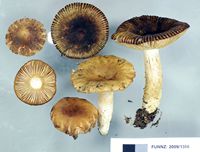
Owner: J.A. Cooper | 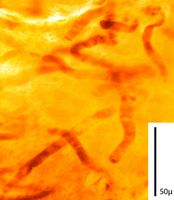
Caption: DCY
Owner: J.A. Cooper | 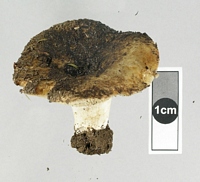
Owner: J.A. Cooper | 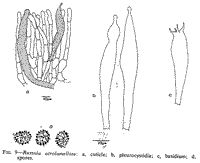 | 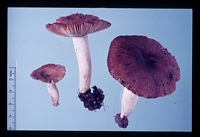
Caption: C-3775, R. acrolamellata
Owner: Herb. PDD | 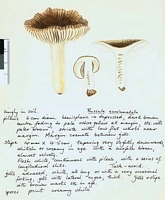
Caption: Watercolour
Owner: G.M. Taylor | 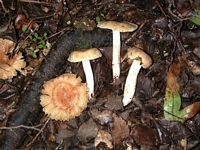
Caption: fruitbody
Owner: J.A. Cooper | 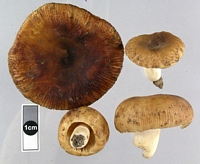
Owner: J.A. Cooper | 
Owner: J.A. Cooper | 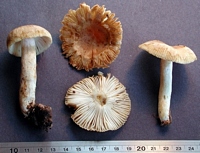
Caption: fruitbody
Owner: J.A. Cooper | 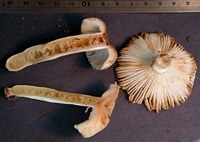
Caption: fruitbody
Owner: J.A. Cooper | 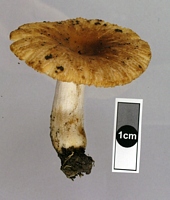
Owner: J.A. Cooper | 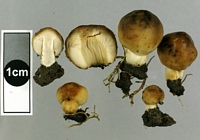
Owner: J.A. Cooper | 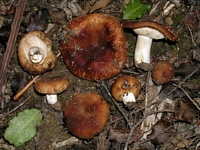
Owner: J.A. Cooper | 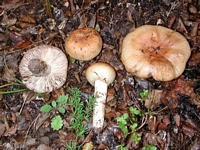
Caption: fruitbody
Owner: J.A. Cooper | 
Owner: P. Leonard | 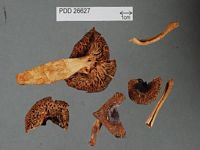
Caption: Dried type specimen
Owner: Herb PDD | 
Owner: J.A. Cooper | 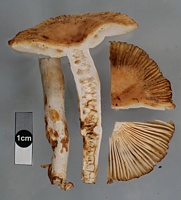
Owner: J.A. Cooper | 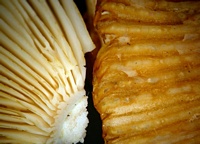
Owner: J.A. Cooper | 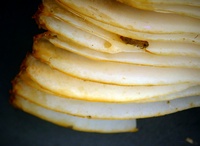
Caption: gill edge colouration
Owner: J.A. Cooper |
Article: McNabb, R.F.R. (1973). Russulaceae of New Zealand. 2. Russula Pers. ex S.F. Gray. New Zealand Journal of Botany 11(4): 673-730 (http://www.rsnz.org/publish/abstracts.php).
Description: pileus: 4.5-7.5 cm diam., convex when young, centrally depressed at maturity, slightly to moderately viscid, glabrous, velar remnants absent, dark brown, chocolate brown, bronze, or dark reddish brown in centre, paling to yellowish brown, greyish yellow or clay towards margins with ridges typically darker than intervening grooves; margins thin, entire, conspicuously pectinate for up to 1.5 cm. Cuticle often separating between adjacent ridges at margin, composed of erect hyphae thin-walled, smooth, septate, 3.5-5 µm diam., terminal cells typically slightly inflated apically, contents often yellowish brown in KOH; pilocystidia fusiform to cylindrical, thin-walled, apices rounded to acuminate, often capitulate, contents refractive in KOH, of variable length, 4-9 µm diam. lamellae: adnexed to adnate, crowded, moderately thin, simple or forked near stipe, to 8 mm deep, pallid creamy white to pallid cream, discoloured with numerous dull brown or dark brown spots and stains at maturity, or with discoloured edges, lamellulae rare to numerous. stipe: 3-6 cm long, ± equal, 1-2 cm diam., chambered or hollow at maturity, dry, subglabrous to finely felted, white to sordid white, typically with brown spots and stains; flesh white to sordid white, unchanging on exposure to air. Cuticle composed of interwoven hyphae 3-6 µm diam., typically aggregated into clumps; caulocystidia similar to pilocystidia. spores: spore print cream: spores broadly elliptical, obliquely apiculate, apiculus to 2 µm long, 10.5-13.5 X 10-12 µm, ornamentation of moderately dense, amyloid or partially inamyloid, truncated spines and crests to 2 µm high, isolated, in small confluent groups, or joined by fine to moderately coarse amyloid ridges and forming a partial reticulum; plage inconspicuous. hymenium: basidia hyaline, clavate, 39-56 X 10.5-13.5 µm, 4-spored, sterigmata to 5.5 µm long; pleurocystidia scattered, numerous, fusiform to irregularly subclavate, hyaline, thin-walled, contents slightly refractive in KOH, projecting to 45 µm beyond basidia, apices strangulate or capitulate, 56-94 X 7-12.5 µm, cheilocystidia similar to pleurocystidia but shorter. hymenophoral trama: heteromerous, intermixed. context of pileus: Sordid white to creamy white, unchanging; structure heteromerous, clamp connections absent. smell: not distinctive, taste: lamellae extremely and persistently acrid; context mild. chemical characters: formalin on context—n.r.; phenol on context—slowly deep vinaceous; FeSO4 on context —rapidly salmon pink; guaiacol on stipe base—rapidly orange, darkening to orange-brown; KOH on pileus—faintly darkening; on context— n.r.; NH4OH on pileus and context—n.r.
Habitat: Solitary or occasionally in pairs under Leptospermum.
Notes: This species could be classified in the section Ingratae Quel. of Singer (1962).
|